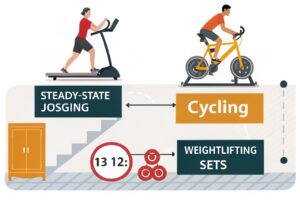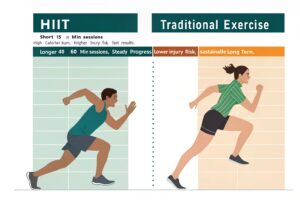Introduction
HIIT vs. Traditional Exercise: Which One is Better for Your Fitness Goals?
If you’ve ever stood in front of a mirror, stared at a crowded gym schedule, or scrolled through endless fitness memes, you’ve probably asked yourself this exact question. The truth is, both High‑Intensity Interval Training (HIIT) and traditional steady‑state workouts have earned their place in modern fitness, but they’re not interchangeable. Understanding the science, the practical benefits, and the personal variables that affect performance can turn a vague curiosity into a concrete plan that aligns with your goals—whether that’s shedding fat, building muscle, boosting endurance, or simply staying active for life.
Understanding HIIT and Traditional Exercise: Core Differences

What is HIIT?

High‑Intensity Interval Training (HIIT) is a time‑pressed, metabolically demanding approach that alternates short bursts of maximal effort (typically 20‑60 seconds) with equal or longer periods of low‑intensity recovery. The classic 30‑second sprint‑followed‑by‑30‑second walk protocol is a prime example. Because you’re repeatedly pushing your heart rate into the 85‑95 % of maximum zone, HIIT triggers a phenomenon called excess post‑exercise oxygen consumption (EPOC)—the “after‑burn” that can keep your metabolism elevated for up to 48 hours after the session (Børsheim & Bahr, 2003).
What is Traditional Exercise?
Traditional exercise—often referred to as steady‑state cardio or conventional strength training—focuses on maintaining a consistent effort level for a longer duration (30–60 minutes or more). This could be a moderate‑pace jog, a cycling session at 65 % of your max heart rate, or a classic “3‑sets‑12‑reps” weight‑lifting routine. The primary goal is to improve aerobic capacity, muscular endurance, or hypertrophy through progressive overload and repetition. While the calorie burn per minute may be lower than a HIIT sprint, the cumulative energy expenditure can be substantial, especially when combined with proper periodization.
Both modalities share foundational principles—movement, overload, recovery—but the intensity‑time matrix sets them apart. Knowing where each falls on that matrix helps you pick the right tool for the job.
How HIIT Impacts Fat Loss, Cardiovascular Health, and Muscular Endurance
HIIT’s reputation as a fat‑melting powerhouse is backed by a growing body of research. A 2020 meta‑analysis of 31 randomized controlled trials found that participants who performed HIIT for just 2–3 sessions per week lost an average of 1.5 kg of body fat more than those who did moderate‑intensity continuous training (MCT), despite a total weekly workout time that was 40 % shorter. The secret lies in EPOC and the recruitment of fast‑ twitch muscle fibers, which are more metabolically active and burn calories at a higher rate even at rest.
On the cardiovascular front, HIIT improves VO₂ max—the gold standard metric for aerobic fitness—more efficiently than traditional cardio. One landmark study published in Cell Metabolism (2015) showed that eight weeks of HIIT raised VO₂ max by 15 %, whereas the same period of steady‑state cycling yielded a modest 6 % increase. This translates to better heart health, lower resting blood pressure, and a reduced risk of chronic diseases such as type‑2 diabetes and hypertension.
When it comes to muscular endurance, HIIT can be surprisingly effective. Because each high‑intensity burst recruits both slow‑ and fast‑ twitch fibers, you develop a hybrid endurance that traditional cardio alone often lacks. A practical example: a 20‑minute HIIT circuit combining kettlebell swings, burpees, and box jumps can improve lower‑body muscular stamina comparable to a traditional 45‑minute rowing session, but in less than half the time.
Comparing Time Efficiency, Injury Risk, and Sustainability

Time Efficiency: The most obvious advantage of HIIT is the condensed workout window. A scientifically designed HIIT session typically lasts 10–20 minutes, making it ideal for busy professionals, parents, or anyone juggling multiple responsibilities. Traditional workouts, while offering a broader scope for skill development, often demand 30–60 minutes per session. If you can only commit to a few days a week, HIIT may deliver comparable—or even superior—physiological adaptations in less calendar time.
Injury Risk: The intensity that defines HIIT also raises the probability of acute injuries if proper form and progression aren’t observed. Repetitive high‑impact moves (e.g., jumping lunges or sprint intervals) can strain joints, especially in individuals with limited mobility or a history of lower‑body injuries. By contrast, traditional steady‑state cardio—such as brisk walking or cycling at a moderate cadence—exerts lower mechanical stress, resulting in a lower overall injury incidence (Koehler et al., 2021). However, the risk can be mitigated by selecting low‑impact HIIT modalities (e.g., rowing, battle‑ropes) and incorporating adequate warm‑up and cool‑down phases.
Sustainability: Long‑term adherence often trumps short‑term gains. Some athletes find HIIT mentally exhausting due to its “all‑or‑nothing” nature, leading to burnout after a few weeks. Traditional exercise, with its rhythmic and predictable pacing, may be more enjoyable for those who thrive on routine. The key to sustainability lies in personalization: alternating between HIIT and steady‑state sessions, varying modalities, and listening to your body’s feedback ensures you stay motivated and injury‑free over months and years.
Choosing the Right Approach for Specific Fitness Goals
Goal 1 – Rapid Fat Loss: If your primary aim is to drop body fat quickly, combine HIIT 2–3 times per week with a slight caloric deficit (≈ 250 kcal/day). Pair sprint intervals on a treadmill with bodyweight circuits (e.g., mountain climbers, push‑ups) to maximize EPOC while preserving lean muscle mass. Supplement with a single traditional cardio day (30 minutes of steady cycling) to aid recovery and improve overall endurance.
Goal 2 – Strength and Hypertrophy: Traditional resistance training remains the gold standard for building muscle size. Structure your week around 4–5 strength sessions using progressive overload (e.g., 5×5 or 3×8 protocols) and reserve HIIT for active recovery or cardio conditioning on off‑days. This approach minimizes interference—commonly referred to as the “concurrent training effect”—that can blunt muscle growth when high‑intensity cardio is performed immediately before or after heavy lifting.
Goal 3 – Improving Cardiovascular Endurance: Athletes targeting race performance—like a 10 km run or a triathlon—should prioritize traditional aerobic workouts (long, steady runs or bike rides) to develop efficient fuel utilization and mental pacing skills. Nevertheless, incorporating HIIT intervals (e.g., 4 × 800 m at race pace with 400 m jog recovery) once per week can boost VO₂ max and lactate threshold, delivering a performance edge without sacrificing the base volume needed for endurance adaptations.
Practical Step‑by‑Step Guide:
Assess your current fitness level using a simple benchmark: a 5‑minute plank, a 1‑mile run, and a 10‑rep max squat.
Define your primary goal (fat loss, strength, endurance) and allocate training time accordingly (e.g., 4 hours/week).
Select a primary modality (HIIT or traditional) that aligns with the goal, then add a complementary modality for balance (e.g., HIIT + 1 day of strength).
Program periodization: 4–6‑week mesocycles where you gradually increase intensity or volume, followed by a deload week.
Track metrics (body composition, lift weights, heart‑rate zones) weekly to adjust the plan based on real data.
By following this roadmap, you’ll avoid the common pitfall of “one‑size‑fits‑all” programming and create a roadmap that evolves with your progress.
Putting It All Together: Personalized HIIT or Traditional Exercise Plan
Creating a sustainable program starts with individualization—your age, training history, injury profile, and lifestyle constraints all dictate the optimal mix. Below is a sample week for a mid‑level fitness enthusiast whose goal is lean muscle gain with improved cardio:
| Day | Primary Focus | Session (Duration) | Example Exercise Set |
|---|---|---|---|
| Mon | Strength (Upper) | 45 min | Bench Press 4×6, Pull‑Ups 3×8, Dumbbell Row 3×10 |
| Tue | HIIT (Low‑Impact) | 20 min | Rowing 30 s max effort / 90 s easy ×8 |
| Wed | Recovery/ Mobility | 30 min | Yoga flow + foam rolling |
| Thu | Strength (Lower) | 45 min | Squat 4×6, Romanian Deadlift 3×8, Bulgarian Split‑Squat 3×10 |
| Fri | Traditional Cardio | 40 min | Steady‑state cycling at 65 % HRmax |
| Sat | HIIT (Bodyweight) | 15 min | 20 s burpees / 40 s rest ×10 |
| Sun | Rest or Light Walk | — | 30‑min walk, enjoy nature |
Key takeaways from this template
-
- Balanced stimulus: Strength days drive hypertrophy, while HIIT injects metabolic conditioning, and the traditional cardio day builds aerobic capacity without overtaxing the nervous system.
-
- Recovery built‑in: Mobility work and an active rest day prevent overtraining—a common cause of dropout for both HIIT‑only and cardio‑only programs.
-
- Progression plan: Every 4 weeks, increase HIIT interval length by 5 seconds, add 5 % load to strength lifts, or extend the steady‑state cardio by 5 minutes.
Frequently Asked Questions
Q1. Can I do HIIT every day?
While short HIIT bursts are tempting, most experts recommend 2–3 sessions per week to allow adequate neuromuscular recovery. Daily high‑intensity work can elevate cortisol levels and blunt muscle growth.
Q2. Does “traditional” mean only cardio?
No. Traditional exercise includes steady‑state cardio, circuit training, and classic resistance training. The term simply denotes a consistent, moderate‑intensity effort over a longer duration.
Q3. Which burns more calories: HIIT or steady‑state?
During the workout, steady‑state may burn more calories per minute. However, HIIT’s after‑burn effect (EPOC) can result in greater total caloric expenditure over a 24‑hour period, especially when combined with a balanced diet.
Q4. I have knee pain—should I avoid HIIT?
Select low‑impact HIIT modalities such as air bike intervals, swimming sprints, or battle‑rope circuits. Always start with a thorough warm‑up and modify movements (e.g., replace jumping lunges with step‑back lunges).
Final Thoughts & Call to Action
Choosing between HIIT vs. Traditional Exercise isn’t a binary decision; it’s a strategic blend tailored to your unique objectives. By understanding the science behind each method, weighing time constraints, injury risk, and long‑term adherence, you can craft a program that maximizes results while keeping you motivated.
Ready to test your new plan? Grab a notebook or a fitness app, log your first week, and share your progress in the comments below. Have questions about specific interval structures or strength protocols? Drop them here, and we’ll dive deeper together. And if you found this guide helpful, please share it on social media—your friends might be looking for the same clarity. For more expert‑backed fitness content, check out our articles on “Periodization for Beginners” and “Nutrition Strategies to Support HIIT”. Happy training!


